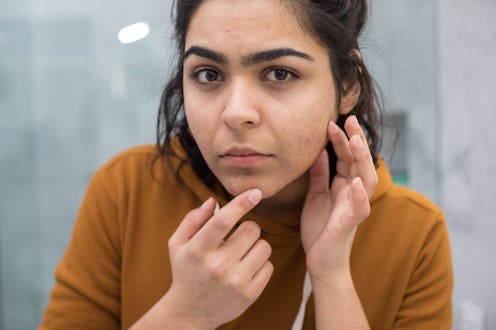Life
6 Types Of Moles You Should Never Ignore

Plenty of people have moles and not all moles are necessarily cause for concern. Sometimes, it can be hard to decipher which need attention and which are harmless, and that is why mole checks are important. However, there are certain types of moles you should never ignore, and if you see moles with these characteristics on your body, you should go see a dermatologist as soon as possible.
When it comes to moles, you can follow the ABCDE rule when he comes to signs of melanoma. This stands for Asymmetry, Border, Color, Diameter, and Evolving. "A typical mole — or one that is not something that needs to be removed to evaluate for cancer — is a solid single color, has a crisp border, is small in size, and looks like other moles on the skin," Dr. Richard Torbeck, board-certified dermatologist with Advanced Dermatology PC, tells Bustle. "Of the ABCDEs, we tend to hold the highest regard for E, which is why we recommend self skin exams."
To monitor your moles, check them every six months by taking a spin in a full length mirror. Watch for drastic changes in a short period of time, and if you see a change, contact a dermatologist. Since some types of moles are more likely to be cancerous than others, experts say you'll want to make sure you never ignore these six types.
1Multicolored Moles
Never ignore a mole that is more than one color or changing in color. "Melanoma cells can develop in moles you have on your body — about 25 percent of melanomas develop from moles you have," Dr. Torbeck says. Melanoma classically tends to produce more and more color, usually changing from brown to black, according to Dr. Rachel Nazarian of Schweiger Dermatology Group. Any moles that have increased in darkness, that are turning black, or just look darker than your other moles should be checked.
2Changing Moles
If any of your moles get larger, thicker, or change their size, see your dermatologist immediately, as continuous growth is a hallmark of cancer. "A mole can change in color size and shape over time, but anything that is changing in a rapid time frame, such as less than three months, should be evaluated further," Dr. Torbeck says.
3Moles That Bleed, Itch, Or Burn
Watch out for moles that are bleeding, itching, or burning, as this can be a sign that the mole may be irritated or undergoing changes where the body's white blood cells are reacting. "Cancers are weak, friable, 'bad' tissue, and they typically outgrow their blood supply and fall apart with even mild trauma," Dr. Nazarian says. "That means if you bump it, even gently, they are more likely to bleed and take long to heal."
4Fading Moles
It might seem like a good thing if your mole starts fading, but this could be a sign your body is trying to fight off abmormal cells and tissue. "If you ever see a mole —or multiple moles — fading, schedule an appointment to see your dermatologist," Dr. Nazarian says. "They may continue to monitor them, or they may suggest a biopsy or other test to make sure everything is OK."
5Pink Or Skin-Colored Moles
Pink or skin-colored moles also deserve attention. "Not all skin cancers come with an ominous dark coloring," Dr. Nazarian says. "Some skin cancers are pink, cream-colored, and make no color at all."
6Moles Underneath Your Nails
Moles can form underneath your nail in what's known as the “nail factory” (also known as the matrix of the nail), and this can cause dark streaks on the nail. "Vertical dark lines on your nails need to be monitored and evaluated like any other mole on your body to check for skin cancer," Dr. Nazarian says. "Never ignore a new or enlarging dark line on your fingernails or toenails."
When in doubt, get your mole checked by a dermatologist, especially if something seems off or abnormal.